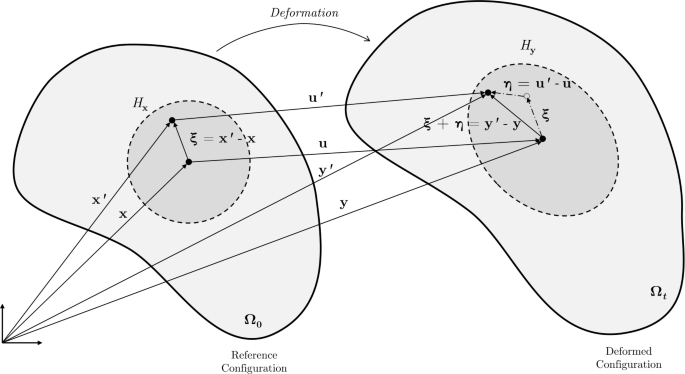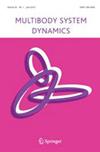A peridynamics approach to flexible multibody dynamics for fracture analysis of mechanical systems
IF 2.4
2区 工程技术
Q2 MECHANICS
引用次数: 0
Abstract
Abstract The classical theory of continuum mechanics is formulated using partial differential equations (PDEs) that fail to describe structural discontinuities, such as cracks. This limitation motivated the development of peridynamics, reformulating the classical PDEs into integral-differential equations. In this theory, each material point interacts with its neighbours inside a characteristic length-scale through bond-interaction forces. However, while peridynamics can simulate complex multi-physics phenomena, its integration in the study of mechanical systems is still limited. This work presents a methodology that incorporates a peridynamics formulation into a planar multibody dynamics (MBD) formulation to allow the integration of flexible structures described by peridynamics into mechanical systems. A flexible body is described by a collection of point masses, in analogy with the meshless collocation scheme commonly used for peridynamics discretisations. Each point mass interacts with other point masses through nonlinear forces governed by a bond-based peridynamics (BBPD) formulation. The virtual bodies methodology enables the definition of kinematic joints connecting the flexible body with the neighbouring bodies. The implementation of the methodology proposed is illustrated using various mechanisms with different levels of complexity. Notched plates subjected to different loading conditions are compared with the results presented in the literature of the peridynamics field. The deformations of a flexible slider-crank mechanism compare well with the results obtained using a classical flexible MBD formulation. Additionally, three scenarios involving a rotating pendulum illustrate how the methodology proposed allows simulating impact scenarios. The results demonstrate how this methodology is capable to successfully simulate highly nonlinear phenomena, including crack propagation, in a multibody framework.

机械系统断裂分析中柔性多体动力学的周动力学方法
连续介质力学的经典理论是用偏微分方程(PDEs)来表述的,它不能描述结构的不连续性,如裂缝。这一限制推动了周动力学的发展,将经典偏微分方程重新表述为积分微分方程。在该理论中,每个材料点通过键相互作用力与特征长度尺度内的相邻点相互作用。然而,虽然周动力学可以模拟复杂的多物理场现象,但它在机械系统研究中的整合仍然有限。这项工作提出了一种将周动力学公式纳入平面多体动力学(MBD)公式的方法,以允许将周动力学描述的柔性结构集成到机械系统中。柔体由质点的集合来描述,类似于通常用于周动力学离散的无网格配置方案。每个质点通过非线性力与其他质点相互作用,非线性力由基于键的周动力学(BBPD)公式控制。虚拟体方法能够定义连接柔性体与相邻体的运动关节。所提出的方法的实现是用不同复杂程度的各种机制来说明的。对不同载荷条件下的缺口板进行了数值模拟,并与已有文献中的结果进行了比较。柔性曲柄滑块机构的变形与经典柔性MBD公式的结果比较好。此外,涉及旋转摆的三个场景说明了所提出的方法如何允许模拟冲击场景。结果表明,这种方法如何能够成功地模拟高度非线性现象,包括裂纹扩展,在一个多体框架。
本文章由计算机程序翻译,如有差异,请以英文原文为准。
求助全文
约1分钟内获得全文
求助全文
来源期刊
CiteScore
6.00
自引率
17.60%
发文量
46
审稿时长
12 months
期刊介绍:
The journal Multibody System Dynamics treats theoretical and computational methods in rigid and flexible multibody systems, their application, and the experimental procedures used to validate the theoretical foundations.
The research reported addresses computational and experimental aspects and their application to classical and emerging fields in science and technology. Both development and application aspects of multibody dynamics are relevant, in particular in the fields of control, optimization, real-time simulation, parallel computation, workspace and path planning, reliability, and durability. The journal also publishes articles covering application fields such as vehicle dynamics, aerospace technology, robotics and mechatronics, machine dynamics, crashworthiness, biomechanics, artificial intelligence, and system identification if they involve or contribute to the field of Multibody System Dynamics.

 求助内容:
求助内容: 应助结果提醒方式:
应助结果提醒方式:


